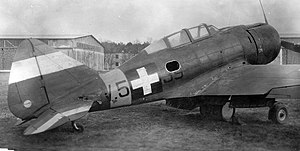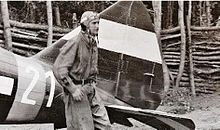avia.wikisort.org - Aeroplane
The MÁVAG Héja ("Hawk") was a Hungarian fighter aircraft based on the Italian Reggiane Re.2000. The 70 Reggiane Re2000s delivered from Italy were modified with Hungarian equipment and fitted with Hungarian-built Manfred Weiss WM K-14 engines. The Héja was re-designed for Hungarian manufacture as the Héja II and a further 203 were built by MÁVAG for the Magyar Királyi Honvéd Légierő (Royal Hungarian Air Force), which used them in operations against the Soviet Union alongside German units.
| Héja | |
|---|---|
 | |
| A MÁVAG Héja II | |
| Role | Fighter |
| National origin | Hungary |
| Manufacturer | MÁVAG |
| First flight | 1940 |
| Introduction | 1941 |
| Retired | 1945 |
| Status | Retired |
| Primary user | Royal Hungarian Air Force |
| Number built | 204 |
| Developed from | Reggiane Re.2000 |
Design and development
In December 1939 seventy Reggiane Re.2000 fighters, purchased from Italy, were delivered to the Magyar Királyi Állami Vas-, Acél- és Gépgyárak, ("Royal Hungarian State Iron, Steel and Machine Works"), where they were modified into MÁVAG Héja I ("Hawk I") fighters. The original Piaggio P.XI engines were replaced by the Hungarian-built Manfred Weiss WM K-14 driving Hamilton Standard three-bladed, constant-speed propellers. The WM K-14 was a licensed copy of the French Gnome-Rhône 14K engine that necessitated a 1-foot 3-inch lengthening of the fighters' forward fuselage, to restore the center of gravity to a safe position. The Piaggio engine was itself also a copy of the Gnome-Rhône 14K, it was more reliable than the Italian engines.
However, the aircraft also suffered from a number of drawbacks. The Hungarian and Italian chemical industries were not able to produce enough good insulation material for wing tanks, thus early planes (Héja I. and all of Italian Re.2000) flown with continuously leaking fuel tanks and late models (Héja II.) had rows of small tanks in the wing, therefore manufacturing complexity and weight of the plane has been increased. Yaw stability was poor and the Héja's predisposition to sideslip was very dangerous at low altitude (it killed István Horthy), moreover the subsequent mass increase of Héja II. has worsened this issue.[1][2]
A decision was soon made to produce more Héja fighters under license in Hungary as the MÁVAG Héja II (Hawk II). The new Héja II was entirely Hungarian with locally produced airframes, engines and armament, which was changed to twin 12.7 mm (0.500 in) Gebauer Motorgeppuska 1940.Minta GKM motor-driven machine guns in the fuselage nose with 300 rpg.[3][4] The first MÁVAG Héja II took to the air on 30 October 1942 and MÁVAG built a further 203 Héja IIs for the Royal Hungarian Air Force, with the last aircraft completed on 1 August 1944.
Operational history

The Kingdom of Hungary was allied to Nazi Germany during World War II, with at least one Hungarian squadron flying the MÁVAG Héja in combat on the Eastern Front. However, most Héjas operated inside Hungary in an air defense role or as a trainer.
On 20 August 1942, personal tragedy struck the Hungarian Regent Miklós Horthy, when 37-year-old István Horthy, Horthy's eldest son, Deputy Regent of Hungary and a Flight Lieutenant in the reserves, was killed while flying Heja V.421 of 1/1 Fighter Squadron Royal Hungarian Air Force near Ilovskoye.[5]
In 1943, 98 Héjas were produced and another 72 in 1944. They were regarded as no longer suitable for combat against modern Soviet fighters and should have served as fighter trainer only.[6] The Luftwaffe was reluctant to re-equip its Hungarian ally: the deliveries of aircraft went primarily to front-line formations and there was still danger of a Hungarian-Romanian conflict. Moreover, Hitler held an extremely bad opinion of the Hungarian aviators.[7] So, the Hungarian Air Force was forced to use the licence-built Reggiane.
The last offensive sortie of the Hejas took place on 2 April 1944, when 180 15th Air Force USAAF bombers, escorted by 170 fighters, bombed the Danube Aircraft Works in Budapest and other targets. The Fighter Control Centre dispatched one wing of Hejas from 1/1 Fighter squadron, along with a couple of Messerschmitt Me 210Cas and 12 Bf 109Gs. The Honvéd pilots claimed 11 American aircraft (six of them confirmed). USAAF pilots reported to have shot down 27 Hungarian aircraft, while only two Hungarians were killed.[8]
Operators
 Kingdom of Hungary
Kingdom of Hungary
- Royal Hungarian Air Force
- 2 Vadászszázad based at Szolnok
- Század Héja
- 1/2.Század 'Keresztes pók
- 2/1.Század 'Keresztes pók
- 1/1.Vadászszázad
- 2/1.Vadászszázad
- 1/1.Század Dongó,Önálló Vadász Osztály (OVO)
Specifications (Héja II)

Data from The Complete Book of Fighters[9]
General characteristics
- Crew: 1
- Length: 8.39 m (27 ft 6 in)
- Wingspan: 11 m (36 ft 1 in)
- Height: 3.1 m (10 ft 2 in)
- Airfoil: N-38[10]
- Empty weight: 2,070 kg (4,564 lb)
- Gross weight: 2,520 kg (5,556 lb)
- Powerplant: 1 × Manfred Weiss WM K.14 14-cyinder air-cooled radial piston engine, 694 kW (931 hp) (Gnome-Rhône 14Kfrs Mistral-Major)
- Propellers: 3-bladed constant-speed propeller
Performance
- Maximum speed: 540 km/h (340 mph, 290 kn) at 4,300 m (14,108 ft)
- Range: 900 km (560 mi, 490 nmi)
- Endurance: 2 hours 30 minutes
- Service ceiling: 8,138 m (26,699 ft)
Armament
- Guns: 2 × fixed forward-firing 12.7 mm (0.500 in) Gebauer Motorgeppuska 1940.Minta GKM motor-driven machine guns in the fuselage nose[3][4]
See also
Aircraft of comparable role, configuration, and era
- Avia B-135
- Bloch MB.152
- CAC Boomerang
- Curtiss P-36 Hawk
- Fiat G.50
- Hawker Hurricane
- Heinkel He 112
- IAR 80
- Macchi MC.200
- Messerschmitt Bf 109
- Mitsubishi A6M Zero
- Nakajima Ki-43
- Reggiane Re.2000
- Rogožarski IK-3
- Seversky P-35
Related lists
- List of aircraft of World War II
- List of fighter aircraft
References
- Elfnet. "MÁVAG Héjja – Elfnet.hu". www.elfnet.hu. Retrieved 1 August 2018.
- Kovács, Béla (2017). "A MÁVAG Héja vadászrepülőgép konstrukciós előzményei és korszerűsítésének lehetőségei az olasz Reggiane vadász-program tükrében, I. rész". Haditechnika. 52/6: 53–57.
- Williams, Anthony G.; Gustin, Emmanuel (2008). Flying guns: the development of aircraft guns, ammunition, and installations, 1933–45. Ramsey: Airlife : The Crowood Press. pp. 16, 18–19, 81–82. ISBN 9781840372274.
- "Hungarian Weapons Gebauer Machine Guns, Hungary 1918–45". www.hungariae.com. Retrieved 25 December 2019.
- Milestones Time
- Neulen 2000, p. 130.
- Neulen 2000, pp. 130–131.
- Neulen 2000, p. 136.
- Green, William; Swanborough, Gordon (1994). The Complete Book of Fighters. London: Salamander. p. 44. ISBN 1-85833-777-1.
- Lednicer, David. "The Incomplete Guide to Airfoil Usage". m-selig.ae.illinois.edu. Retrieved 16 April 2019.
Further reading
- Neulen, Hans Werner (2000). In the skies of Europe: Air Forces Allied to the Luftwaffe, 1939-1945. Ramsbury, UK: Crowood. ISBN 1-86126-799-1.
На других языках
- [en] MÁVAG Héja
[it] MÁVAG Héja II
Il MÁVAG Héja II era un caccia monomotore e monoplano ad ala bassa sviluppato dall'azienda aeronautica ungherese Magyar Állami Vagon és Gépgyár (MÁVAG) nei primi anni quaranta.Другой контент может иметь иную лицензию. Перед использованием материалов сайта WikiSort.org внимательно изучите правила лицензирования конкретных элементов наполнения сайта.
WikiSort.org - проект по пересортировке и дополнению контента Википедии